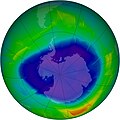پرونده:2009 Antarctic Ozone Hole (3927062424).jpg

اندازهٔ این پیشنمایش: ۶۰۰ × ۶۰۰ پیکسل. کیفیتهای دیگر: ۲۴۰ × ۲۴۰ پیکسل | ۴۸۰ × ۴۸۰ پیکسل | ۷۱۶ × ۷۱۶ پیکسل.
پروندهٔ اصلی (۷۱۶ × ۷۱۶ پیکسل، اندازهٔ پرونده: ۲۸۳ کیلوبایت، نوع MIME پرونده: image/jpeg)
تاریخچهٔ پرونده
روی تاریخ/زمانها کلیک کنید تا نسخهٔ مربوط به آن هنگام را ببینید.
| تاریخ/زمان | بندانگشتی | ابعاد | کاربر | توضیح | |
|---|---|---|---|---|---|
| کنونی | ۱۲ مهٔ ۲۰۱۸، ساعت ۰۱:۲۸ |  | ۷۱۶ در ۷۱۶ (۲۸۳ کیلوبایت) | OceanAtoll | Transferred from Flickr via #flickr2commons |
کاربرد پرونده
این پرونده در هیچ صفحهای به کار نرفته است.
کاربرد سراسری پرونده
ویکیهای دیگر زیر از این پرونده استفاده میکنند:
- کاربرد در de.wikibooks.org
- کاربرد در en.wikibooks.org
